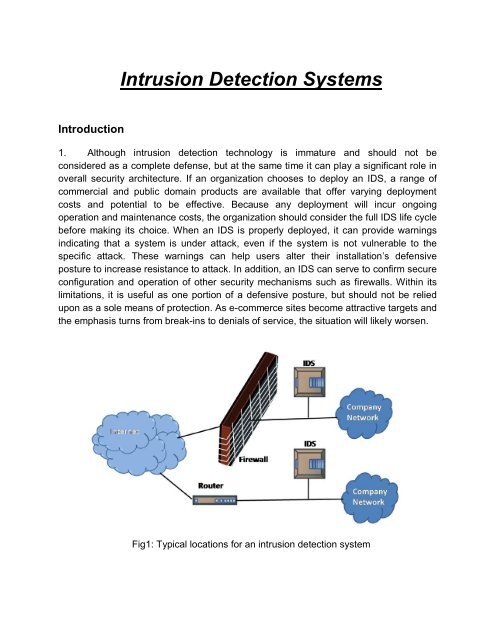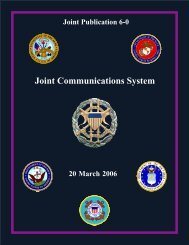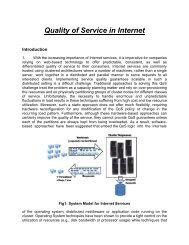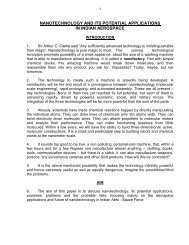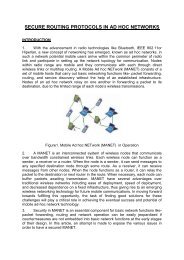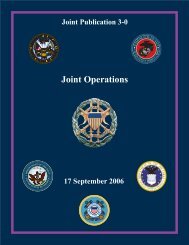Intrusion Detection Systems - Integrated Defence Staff
Intrusion Detection Systems - Integrated Defence Staff
Intrusion Detection Systems - Integrated Defence Staff
You also want an ePaper? Increase the reach of your titles
YUMPU automatically turns print PDFs into web optimized ePapers that Google loves.
<strong>Intrusion</strong> <strong>Detection</strong> <strong>Systems</strong>Introduction1. Although intrusion detection technology is immature and should not beconsidered as a complete defense, but at the same time it can play a significant role inoverall security architecture. If an organization chooses to deploy an IDS, a range ofcommercial and public domain products are available that offer varying deploymentcosts and potential to be effective. Because any deployment will incur ongoingoperation and maintenance costs, the organization should consider the full IDS life cyclebefore making its choice. When an IDS is properly deployed, it can provide warningsindicating that a system is under attack, even if the system is not vulnerable to thespecific attack. These warnings can help users alter their installation’s defensiveposture to increase resistance to attack. In addition, an IDS can serve to confirm secureconfiguration and operation of other security mechanisms such as firewalls. Within itslimitations, it is useful as one portion of a defensive posture, but should not be reliedupon as a sole means of protection. As e-commerce sites become attractive targets andthe emphasis turns from break-ins to denials of service, the situation will likely worsen.Fig1: Typical locations for an intrusion detection system
2Many early attackers simply wanted to prove that they could break into systems;increasingly nowadays, the trend is toward intrusions motivated by financial, political,and military objectives. In the 1980s, most intruders were experts, with high levels ofexpertise and individually developed methods for breaking into systems. They rarelyused automated tools and exploit scripts. Today, anyone can attack Internet sites usingreadily available intrusion tools and exploit scripts that capitalize on widely knownvulnerabilities. Today, damaging intrusions can occur in a matter of seconds. Intrudershide their presence by installing modified versions of system monitoring andadministration commands and by erasing their tracks in audit and log files. In the 1980sand early 1990s denial-of-service attacks were infrequent and not considered serious.Today, successful denial-of-service attacks can put e- commerce based organizationssuch as online stockbrokers and retail sites out of business. Successful IDSs canrecognize both intrusions and denial-of-service activities and invoke countermeasuresagainst them in real time. To realize this potential, we’ll need more accurate detectionand reduced false-alarm rates.Perspectives on <strong>Intrusion</strong>: Victims and Attackers2. Attacks can involve numerous attackers targeting targeting many victims.Defining what constitutes an attack is difficult because multiple perspectives areinvolved. The attacker viewpoint is typically characterized by intent and risk of exposure.From a victim’s perspective, intrusions are characterized by their manifestations, whichmight or might not include damage. Some attacks produce no manifestations and someapparent manifestations are caused by system or network malfunctions. Some attacksinvolve the (involuntary) participation of additional machines, usually victims of earlierattacks. For an intrusion to occur there must be both an overt act by an attacker and amanifestation, observable by the intended victim, that results from that act.Dimensions of <strong>Intrusion</strong> <strong>Detection</strong>3. We can characterize IDSs in a variety of ways. Here, we choose the systemstructure, sensed phenomenology, and detection approach. Figure 2 illustrates systemstructure and sensed phenomenology. The figure shows a small enterprise configuredwith firewalls to isolate its Web server. Computers configured as network sensorsextract suspicious packets from the three main network segments and forward them toa network-specific analysis station. The Web server and workstations run software tomonitor suspicious interactions with the operating system and report them to a hostspecificanalysis station. In addition, the Web server looks for abuses such as CGI-binexploits that are specific to HTTP servers. The analyzers report to a managementconsole that serves as the IDS’s user interface. The management console alerts theenterprise administration who might, in turn, report intrusions to incident- incident-
3response organizations such as the CERT Coordination Center. More elaborateconfigurations are possible. An analyzer might use inputs from any or all sensedphenomenologies in deciding whether an attack has taken place. Analyzer outputs canalso serve as sensed data for other analyzers.Fig 2: Illustrates system structure and sensed phenomenology<strong>Intrusion</strong> <strong>Detection</strong> Approaches4. In classical signal-detection approaches, both the signal and the noisedistributions are known, and a decision process must determine whether a givenobservation belongs to the signal-plus noise distribution or to the noise distribution.Classical signal detectors use knowledge of both distributions in making a decision, butintrusion detectors typically base their decisions either on signal (signature-baseddetectors) or noise (anomaly-based detectors) characterizations. Each approach hasstrengths and weaknesses. Both suffer from the difficulty of characterizing thedistributions. For signature-based IDS to detect attacks, it must possess an attackdescription that can be matched to sensed attack manifestations. This can be as simpleas a specific pattern that matches a portion of a network packet or as complex as astate machine or neural network description that maps multiple sensor outputs to
4abstract attack representation. If an appropriate abstraction can be found, signaturebasedsystems can identify previously unseen attacks that are abstractly equivalent toknown patterns. They are inherently unable to detect truly novel attacks and suffer fromfalse alarms when signatures match both intrusive and nonintrusive sensor outputs.Signatures can be developed in a variety of ways, from hand translation of attackmanifestations to automatic training or learning using labeled sensor data. Because agiven signature is associated with a known attack abstraction, it is relatively easy for asignature-based detector to assign names (such as Smurf or Ping-of-Death) to attacks.Anomaly-based detectors equate “unusual” or “abnormal” with intrusions. Given acomplete characterization of the noise distribution, an anomaly-based detectorrecognizes as an intrusion any observation that does not appear to be noise alone. Theprimary strength of anomaly detection is its ability to recognize novel attacks. Itsdrawbacks include the necessity of training the system on noise with the attendantdifficulties of tracking natural changes in the noise distribution.5. Changes can cause false alarms, while intrusive activities that appear to benormal can cause missed detections. Anomaly- based systems have difficultyclassifying or naming attacks. We can also classify IDSs based on the phenomenologythat they sense. Network-based systems look at packets on a network segment,typically one serving an enterprise or a major portion of one. While network-basedsystems can simultaneously monitor numerous hosts, they can suffer from performanceproblems, especially with increasing network speeds. Many network-based systemsmake simplifying assumptions about such network pathologies as packet fragmentationand can suffer from resource exhaustion problems when they must maintain attackstateinformation for many attacked hosts over a long period of time.6. In spite of these deficiencies, they are popular because they are easy to deployand manage as standalone components and they have little or no impact on theprotected system’s performance. Host-based systems operate on the protected host,inspecting audit or log data to detect intrusive activity. A variety of log and auditfunctions can serve to drive ID algorithms; these can be supplemented by sensors thatmonitor the interaction of applications with the host operating system. Host-basedsystems can monitor specific applications in ways that would be difficult or impossible ina network-based system. They can also detect intrusive activities that do not createexternally observable behavior. Because they consume resources on the protectedhost, they can affect performance substantially. Successful intrusions that gain highlevels of privilege might be able to disable host-based IDSs and remove traces of theiroperation. Installing and effectively using IDSs on networks and hosts requires a broadunderstanding of computer security.Preparation
57. Before an organization invests in security technologies, it must understand whichof its assets require protection and determine the real and perceived threats againstthose assets. We can characterize threats by the likely type of attack and attackercapabilities (that is, resources and goals) and the organization’s tolerance for loss of,damage to, or disclosure of protected assets. Attacker motives can be arbitrary(curiosity or vandalism) or targeted to meet a specific objective such as revenge orgaining a competitive advantage. Motives can make some forms of attack more likelythan others. Gaining a competitive advantage might require compromising specificinformation such as a marketing plan. Each form of attack requires diverse detectionstrategies. For example, information retrieval is likely to occur during a stealthy attack,while information corruption might require speed. Determining whether the potentialattacker is inside or outside the organization’s infrastructure affects the type andplacement of an IDS. Often, the most significant obstacle to an information securityimprovement initiative is lack of management support. Surveys conducted by securitytrade magazines cited lack of management support as one of the principle barriers toeffective information security. Security only becomes important when it impinges on theorganization’s high-priority interests and reputation. Deploying and operating an IDSrequires significant management support.Defense in Depth8. ID is only one aspect of a layered defensive posture or “defense in depth.”Defense in depth begins with the establishment of appropriate and effective securitypolicies. Effective policies help ensure that threats to critical assets are understood,managers and users are adequately trained, and actions to be taken when an intrusionis identified are defined. A good security policy puts ID in its proper perspective andcontext. Whenever possible, the policy should reflect the mission of the organizationthat promulgates it. Therefore, it should codify the rules governing enterprise operationsas they are reflected in its information infrastructure and should explicitly excludeactivities or operations not needed to support the enterprise’s mission. A missionorientedsecurity policy can aid in configuring both firewalls and IDSs. Establishing alayered security architecture is advantageous whether an IDS is deployed or not. Inaddition to formulating a security policy, the essential steps consist of implementinguser authentication and access controls, eliminating unnecessary services, applyingpatches to eliminate known vulnerabilities, deploying firewalls, using file integritychecking tools such as Tripwire, and so forth. Because most real-time commercial IDSsbase their detection approach on known attempts to exploit known vulnerabilities, anadministrator’s time is often better spent minimizing vulnerability through the applicationof patches or other security measures. Detecting and responding to penetrationattempts that cannot succeed (such as Unix-specific at attempts against a network of
6Windows machines) is not an effective use of resources, except as an indication ofthreat level. Using a network sensor outside the protected network lets theadministrator sense the general threat level as indicated by probes and attempts thatwill be blocked by the outer firewall. Comparing the observations of sensors on bothsides of the firewall lets the analyzer be configured to validate the firewall rules. Theinternal firewall provides an additional layer of defense for the inside workstations byexcluding traffic that must reach the Web server from the outside but that should notreach the inside. In addition to helping to validate the inner firewall’s rules, it alsoprotects the inside should the Web server be compromised and used as a base toattack the inside. If we assume that the protected enterprise is mission-oriented andonly runs a limited set of applications and protocols, we can configure the inner sensorto recognize as intrusive any unexpected protocols. Host-based sensors on eachworkstation or server can look for both unexpected applications and abnormal behavioron the part of supported applications and the host operating system. When we combinethe use of multiple firewalls and sensors configured to support a mission-specificsecurity policy with a proactive vulnerability remediation policy, the removal ofunneeded services, and the regular and careful use of integrity checking tools, theintruder’s task becomes much more difficult.The IDS Life Cycle9. Vendors frequently release new IDS products and aggressively compete formarket share. Hiring and retaining personnel to competently administer security ingeneral and intrusion detection in particular are increasingly challenging. Rapid changesin information technology make it difficult for an organization to implement an effective,long-term security strategy.• Evaluation and selection: If an organization plans to acquire an IDS, it shouldconsider the resources available for the system’s operation and maintenance andchoose one than meets its needs within these constraints. This is difficultbecause there are no industry standards against which to compare IDSs. Thenew product cycle for commercial IDSs is rapid, and information and systemsquickly become obsolete. IDS vendors usually specify which prototypical attackstheir systems can find, but without access to deployment environments, theycannot describe how well their systems detect real attacks while avoiding falsealarms. Topics to consider include detection and response characteristics, use ofsignature and anomaly-based approaches, diagnosis accuracy (false-alarm rate),ease of use, effectiveness of user interface, and quality of vendor support.• Deployment: Issues to address include placement of sensors to maximizeprotection for the most critical assets, configuring the IDS to reflect security
7policy, installing appropriate signatures and other initial conditions, establishingforensic procedures to preserve evidence for possible prosecutions, anddetermining when and what automatic responses are allowed. Users mustdevelop procedures for handling IDS alerts and consider how to correlate alertswith other information such as system or application logs. Integrating the IDS intoa comprehensive system man management framework would simplify this lattertask.• Operation and use: Once an organization deploys an IDS, it must monitor thesystem and respond to the alerts that it reports. This means establishing rolesand responsibilities for analyzing and acting on alerts, monitoring the outcomesof both manual and automatic responses, and so forth. IDSs themselves arelogical targets for attack. Smart intruders who realize that an IDS has beendeployed on a network their attacking is likely attack the IDS first, disabling it orforcing it to provide false information (distracting security personnel from theactual attack in progress). In addition, many commercial and research ID toolshave security weaknesses resulting from flawed design assumptions. These caninclude failing to encrypt log files, omitting access control, and failing to performintegrity checks on IDS files.• Maintenance: Activities include installing new signatures as they becomeavailable, as well as installing periodic IDS upgrades. Sensor placement shouldbe revisited periodically to ensure that system or network changes have notreduced the effectiveness of the IDS. Use of technology alone is not sufficient tomaintain network security. An organization must attract, train, and retain qualifiedtechnical staff to operate and maintain ID technologies.• <strong>Intrusion</strong> <strong>Detection</strong> Technology: Commercial ID technology is immature anddynamic to the point of instability. New vendors appear, only to be absorbed byothers. Both commercial and research products evolve rapidly. Oneconsequence of this rapid change is that product lists, surveys, and a variety ofcommercial, research, and public domain ID tools are available.Commercial products10. Given today’s volatile marketplace, it’s best to use a Web search to locatecurrent products, reviews, and so forth. Commercial product literature is generallyweighted towards marketing, which often makes it difficult to determine the product’sfunctionality and detection approach. Virtually no commercial literature addressesissues such as the frequencies of false alarms, missed detections, or the system’ssensitivity to traffic loads.
8• RealSecure from Internet Security <strong>Systems</strong> (www.iss.net) is a real-time IDS thatuses a three-part architecture consisting of a network-based recognition engine,a host-based recognition engine, and an administrator’s module. The networkrecognition engine runs on dedicated workstations to provide network intrusiondetection and response. Each network-recognition engine monitors a networksegment looking for packets that match attack signatures. When a networkrecognitionengine detects intrusive activity, it can respond by terminating theconnection, sending alerts, recording the session, reconfiguring firewalls, and soforth. The host-based engines analyze log data to recognize attacks. Each hostengine examines its system’s logs for evidence of intrusions and securitybreaches. Log data can contain information that is difficult or impossible to inferfrom network packet data. The host engine can prevent further incursions byterminating user processes or suspending user accounts. An administrativemodule manages multiple-recognition engines. The result is comprehensiveprotection, easily configured and administered from a single location. Theadministrative module is supplied with both recognition engines and is alsoavailable as a plug-in module for a variety of network and systems managementenvironments.• Tripwire is a file integrity assessment tool (www.tripwire. com) that isuseful for detecting the effects of an intrusion. Tripwire creates a database ofcritical system file information that includes file lengths and cryptographicchecksums based on each file’s contents. Tripwire compares current informationwith a previously generated baseline and identifies changed files. Tripwire willreport modified files, but the user must decide whether the modifications resultedfrom an intrusion. Because most monitored files are not expected to changeexcept when new software versions are installed, changes usually indicate anunexpected or unauthorized activity. For reliable Tripwire results, users mustprotect the database and program from tampering, either by maintaining themoffline or online using read-only storage media• Shadow and Snort, two public-domain ID tools, are unlikely to have thesame level of support as commercial systems, so users will need a higher level oftechnical expertise to install and manage them. The effort involved is likely to payoff with a better understanding of ID and its strengths and limitations. Sensorsusually reside at key monitoring points in the network, such as outside a firewall,while the analysis station resides inside the firewall. The sensor is based on publicdomain packet-capture software and does not preprocess the data, thuspreventing an intruder from determining the detection objectives by capturing anunprotected sensor. Sensors extract packet headers and save them to a file thatthe analysis station reads periodically. The analysis station uses a Web-based
9interface to display filtering results as well as raw data. Shadow runs on manyUnix systems and Linux.Snort is a recent open-source public-domain effort to build a lightweight, efficient,ID tool that can be deployed on a wide variety of Unix platforms. According to theSnort Web site (www.snort.org), views are quickly outdated. The “Technology”sidebar describes a sample of commercial, research, and public domain tools.Snort is a lightweight network intrusion detection system, capable of performingreal-time traffic analysis and packet logging on IP networks. It can performprotocol analysis, content searching/ matching and can be used to detect a varietyof attacks and probes, such as buffer overflows, stealth port scans, CGI attacks,SMB probes, OS fingerprinting attempts, and much more. Snort uses a flexiblerules language to describe traffic that it should collect or pass, as well as adetection engine that utilizes a modular plugin architecture. Snort is currentlyundergoing rapid development. The user community is contributing auxiliary toolsfor analyzing and summarizing snort logs, providing additional capabilities. Moreimportantly, there is a large group of users who contribute new signatures. As aresult, new attacks are quickly represented in the signature database.Conclusion11. <strong>Intrusion</strong> detection systems (IDSs) attempt to identify computer system andnetwork intrusions and misuse by gathering and analyzing data. IDSs have traditionallybeen developed to detect intrusions and misuse for wired systems and networks. Morerecently, IDSs have been developed for use on wireless networks. These wireless IDSscan monitor and analyze user and system activities, recognize patterns of knownattacks, identify abnormal network activity, and detect policy violations for WLANs.Wireless IDSs gather all local wireless transmissions and generate alerts based eitheron predefined signatures or on anomalies in the traffic.12. <strong>Intrusion</strong> detection systems are an important addition to the security of wirelesslocal area networks. While there are drawbacks to implementing a IDS, the benefits willmost likely prove to outweigh the downsides. With the capability to detect probes, inaddition to assistance with policy enforcement, the benefits of a wireless IDS can besubstantial. Of course, just as with a wired network, an IDS is only one part of a greatersecurity solution wireless network. WLANs require a number of other securitymeasures to be employed before an adequate level of security can be reached, but theaddition of a wireless IDS can greatly improve the security posture of the entire network.With the immense rate of wireless adoption, the ever-increasing number of threats toWLANs, and the growing complexity of attacks, a system to identify and report on threatinformation can greatly enhance the security of a wireless network.


